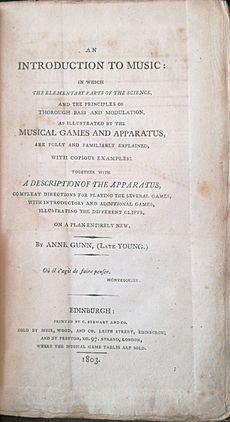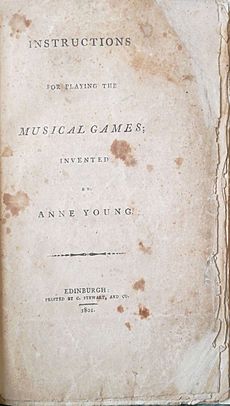Anne Gunn facts for kids
Anne Gunn (born Young; 11 April 1756 – c. 1813) was a Scottish music teacher and a clever inventor. She created Musical Games, which were special board games. These games were designed to help children learn about music theory in a fun way. She made history in 1801 by getting the first British patent ever for a board game. She was also the only female inventor to get a patent that year!
Contents
Anne Gunn's Early Life
Anne Young was born in Haddington, Scotland, on April 11, 1756. Her father, David Young, was a music teacher and later became the head of the local grammar school. Anne was the youngest of 11 children. Her brother, Walter Young, was also a talented musician. He even worked with the famous poet Robert Burns. Anne said that her father and brother helped her become very good at music, especially understanding music theory.
Anne's Career as a Music Teacher
Anne Young worked as a music teacher in Edinburgh. She taught music to young ladies. She also wrote two books about how to play and read music. Her first book was called Elements of Music and of Fingering the Harpsichord. It was first published around 1790. Her second book, An Introduction to Music, came out in 1803.
Inventing Musical Games
On March 16, 1801, Anne Young received a special permission called a Royal patent for her Musical Games. This was a set of six games designed to teach the basics of music theory. The games were played on a special board that came in a fancy mahogany box. It also included wooden pins and dice made of ivory.
This was a very important moment! It was the first time a British patent was given for a board game. Anne was also the only female inventor to get a patent in 1801. At first, the games came with a book of instructions. Later, Anne updated the instructions and added even more games.
Why Anne Invented the Games
Anne believed her board games were perfect for children. She knew that teaching music theory could sometimes be boring for both teachers and students. This was because it needed a lot of repetition to learn the basic ideas. She hoped her games would make learning music more fun and engaging for kids.
She observed that:
‘There is one thing, however, in which all children agree, and that is a fondness for sport or play. Proceeding upon this principle, various successful attempts have been made to invent certain sports or games, which afford amusement, and at the same time communicate, or impress upon the memory, some branches of useful knowledge.’
What the Games Taught
Each of the games helped players learn important music concepts. They taught how to identify:
- Clefs (symbols that show the pitch of notes)
- Intervals (the distance between two notes)
- Cadences (musical endings)
- Scales (a series of notes in order)
- Chords (groups of notes played together)
- Modulations (changes in the musical key)
Her book, An Introduction to Music, gave more detailed instructions for each game. Anne even added a new game about key signatures. She did this because some people had given feedback after the games were first released.
After Anne's death, An Introduction to Music was reissued in 1820. This new version included six more "Elementary Games." These games taught even more basic music theory. They were probably meant to be played before moving on to the original games.
Anne's Personal Life
Anne Young married John Gunn, a writer and cellist, on July 20, 1802. They were married at St Cuthbert’s Church in Edinburgh. After she got married, Anne stopped working as a music teacher. She passed away in 1813.



